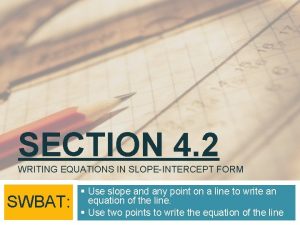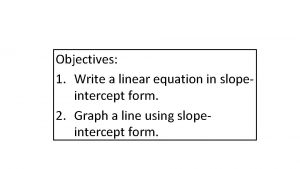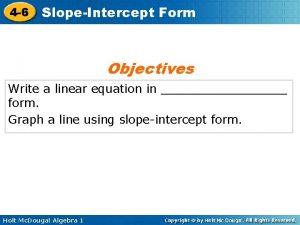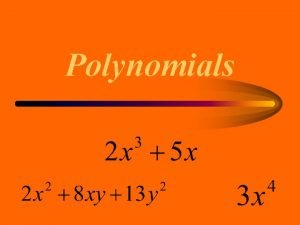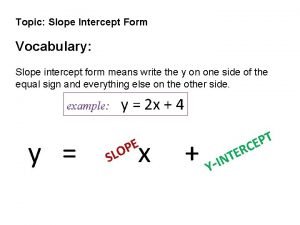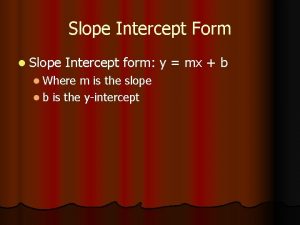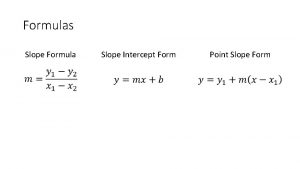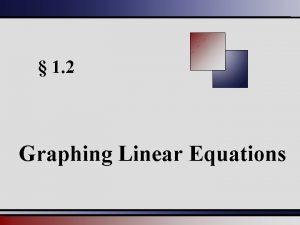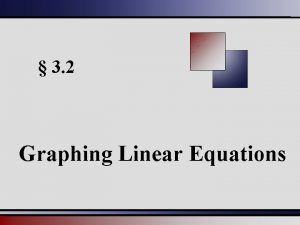LESSON 8 POLYNOMIALS GRAPHING LINEAR EQUATIONS INTERCEPT SLOPE

















- Slides: 17

LESSON 8: POLYNOMIALS, GRAPHING LINEAR EQUATIONS, INTERCEPT -SLOPE METHOD

It is convenient to have a word to describe the simplest kind of algebraic expressions. These expressions have coefficients that are real numbers and variables that have whole numbers as exponents. No fractional exponents or negative exponents are allowed. The following are examples of these very simple expressions. 2 2 -4 ½ 2 x -3 x -5 x + 6 x + 2

Unfortunately, we use an intimidating word to designate these simple expressions, and the word is polynomial. It would have been helpful had we called them “simplenomials” instead, but we can think “simplenomial” whenever we hear the word polynomial.

A polynomial in one variable has a real number for a coefficient and has one of the numbers 0, 1, 2, 3… as the exponent of the variable. Thus, all of the following are polynomials. They are also called monomials because they have only one term. -4 2 x 2 3 x 14 0. 004 x 5 √ 2 x

Polynomials of two terms are called binomials, and polynomials of three terms are called trinomials. x+2 4 x + 2 x 2 2 x + 3 x + 2

The degree of a polynomial is the same as the degree of the highest-degree term of the polynomial. x 4+ 2 is a first degree polynomial. x + 4 is a fourth 2 degree polynomial. 2 x + 3 x + 2 is a second degree polynomial because the greatest exponent is 2.

An equation that contains only polynomial terms is called a polynomial equation. The degree of a polynomial equation is the same as the degree of the highest degree term in the equation. Thus, the equations 2 x + 3 y = 6 3 x – 2 y = 0 -3 x = 2 y + 4 Are all first degree polynomial equations. If we use two number lines to form a coordinate plane, we can graph the set of ordered pairs of x and y that satisfy one of these equations. The graph of a first degree polynomial equation in two unknowns is a straight line.

To find tow or more ordered pairs of x and y that satisfy the equation of a line, we often use five steps. 1. Solve the equation for y 2. Make a table and select convenient values of x 3. Use these values of x in the equation to find the matching values of y 4. Complete the table 5. Graph the ordered pairs and draw the line

Example: Graph the equation 2 x + 3 y = 6.

Answer: y = -2/3 x + 2 (0, 2) (6, -2) (-6, 6)

The method of graphing a line before is exact and will always work. However, the method is time consuming and there is a quicker way to graph a line that is just as accurate.

Recall that two points are all that is needed to graph a line. We can use the y intercept as one of those points and use the slope to find another point. Since we use the intercept first, we call this method the intercept slope method.

Example: Graph the same equation again using intercept slope method. 2 x + 3 y = 6

Answer: y = -2/3 x + 2

Example: Use the intercept-slope method to graph the line y = -3 x – 3.

Answer: See example

HW: Lesson 8 #1 -30
 4-1 practice graphing equations in slope intercept form
4-1 practice graphing equations in slope intercept form Rewriting linear equations in slope intercept form
Rewriting linear equations in slope intercept form Slope intercept form simplifier
Slope intercept form simplifier X intercept form
X intercept form Graphing lines in slope intercept form
Graphing lines in slope intercept form Point-slope form definition geometry
Point-slope form definition geometry 5-6 graphing inequalities in two variables answer key
5-6 graphing inequalities in two variables answer key 4-2 writing equations in slope-intercept form
4-2 writing equations in slope-intercept form Converting equations to slope intercept form
Converting equations to slope intercept form Lesson 4 slope intercept form
Lesson 4 slope intercept form 2-4 practice writing linear equations
2-4 practice writing linear equations 4-1 writing equations in slope-intercept form
4-1 writing equations in slope-intercept form Write an equation of the line in slope intercept form
Write an equation of the line in slope intercept form 2-3 linear functions and slope-intercept form
2-3 linear functions and slope-intercept form Slope intercept form problems
Slope intercept form problems Slope intercept form lesson 4
Slope intercept form lesson 4 Lesson 4-6 slope intercept form answer key
Lesson 4-6 slope intercept form answer key X intercept and y intercept
X intercept and y intercept







